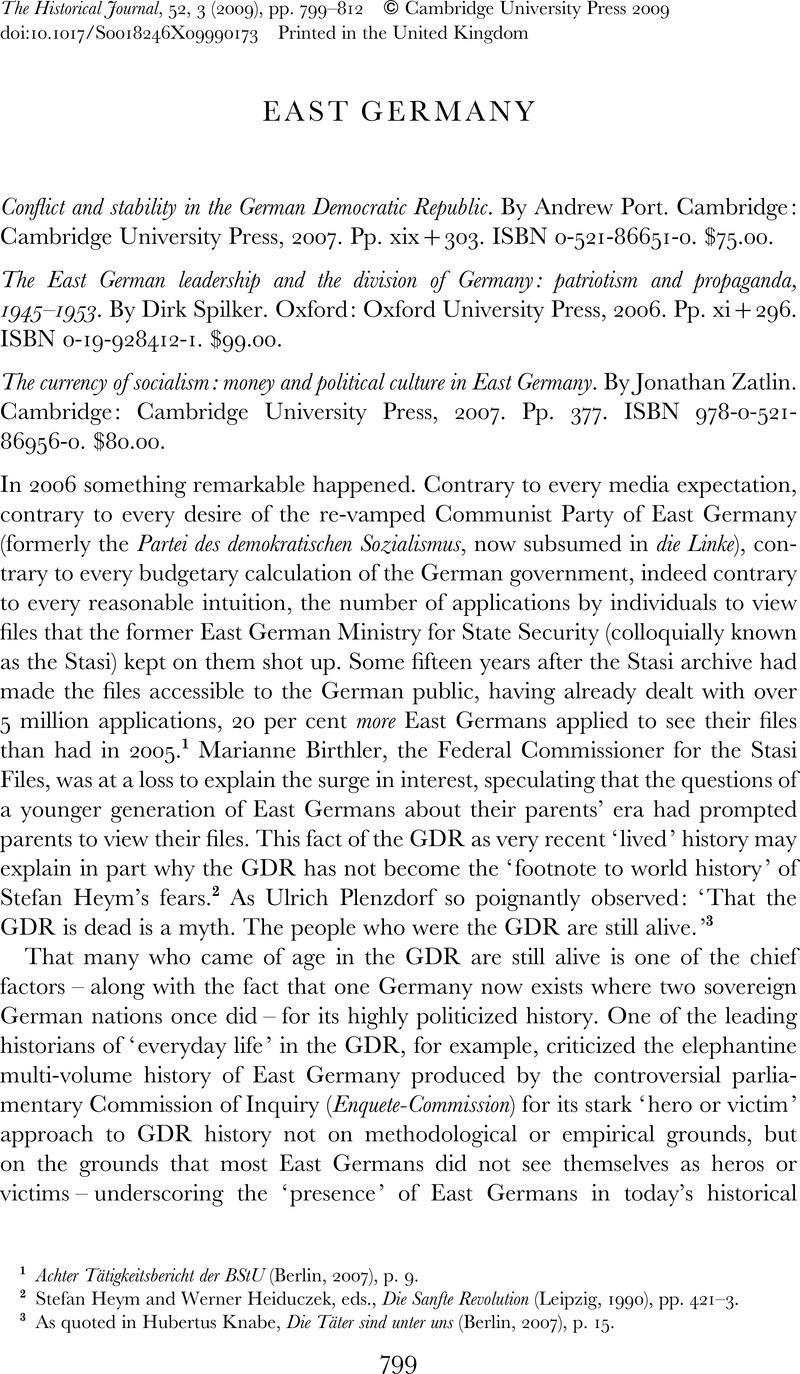No CrossRef data available.
Published online by Cambridge University Press: 04 August 2009

1 Achter Tätigkeitsbericht der BStU (Berlin, 2007), p. 9.
2 Stefan Heym and Werner Heiduczek, eds., Die Sanfte Revolution (Leipzig, 1990), pp. 421–3.
3 As quoted in Hubertus Knabe, Die Täter sind unter uns (Berlin, 2007), p. 15.
4 Thomas Lindenberger, ‘Everyday history: new approaches to the history of the post-war Germanies’, in Christoph Kleßmann, ed., The divided past (Oxford, 2001), p. 53.
5 Jürgen Kocka and Martin Sabrow, eds., Die DDR als Geschichte (Berlin, 1994), p. 66.
6 See Mark Kramer's outstanding review of Loth: ‘The Soviet Union and the founding of the German Democratic Republic: 50 years later – a review article’, Europe-Asia Studies, 51 (1999), pp. 1093–124.
7 Ibid., p. 1097. For Wettig's stance, see in particular Gerhard Wettig, Bereitschaft zu Einheit in Freiheit? Die sowjetische Deutschland-Politik, 1945–1955 (Munich, 1999); and most recently Stalin and the Cold War in Europe: the emergence and development of east–west conflict, 1939–1953 (Lanham, MD, 2007).
8 Gary Bruce, Resistance with the people (Lanham, MD, 2003), p. 242.
9 Anthony Nicholls, ‘Der Dritte Weg im Zeitalter des Kalten Krieges – einfűhrende Űberlegungen’, in Dominik Geppert and Udo Wengst, eds., Neutalität – Chance oder Chimäre (Munich, 2005), p. 19.
10 Hope Harrison, Driving the Soviets up the wall (Princeton, NJ, 2005).
11 See Jan Foitzik, ‘Zum Verhältnis zwischen SED und Besatzungsmacht: Konkordanz und Dissens’, in Dierk Hoffmann and Hermann Wentker, eds., Das letzte Jahr: Politische Weichenstellungen und Kontinuitäten im Prozeß der Gründung der DDR (Munich, 2001).
12 Gerhard Ritter, ‘Der 17. Juni 1953’, in Ilko-Sascha Kowalczuk and Roger Engelmann, eds., Volkserhebung gegen den SED-Staat (Göttingen, 2005), p. 27. Other notable works from 2003 are Ilko-Sascha Kowalczuk, 17.6.1953:Volksaufstand in der DDR (Berlin, 2003); Thomas Flemming, Der 17. Juni 1953 (Berlin, 2003); Rolf Steininger, 17. Juni 1953 (Munich, 2003); on the historical significance of 17 June, see Bernd Eisenfeld, Ilko-Sascha Kowalczuk and Erhart Neubert, Die verdrängte Revolution: Der Platz des 17.Juni in der deutschen Geschichte (Bremen, 2004).
13 Tony Judt refers to 17 June 1953 as the ‘Berlin Uprising’ in Post war: a history of Europe since 1945 (New York, NY, 2005), p. 177.
14 Some notable exceptions are Peter Grieder, The East German leadership, 1946–1973 (Manchester, 1999); Gareth Pritchard, The making of the GDR, 1945–1953: from antifascism to Stalinism (Manchester, 2000); Alan McDougall, Youth politics in East Germany: the Free German Youth Movement, 1946–1968 (Oxford, 2004); Mark Allinson, Politics and popular opinion in East Germany, 1945–1966 (Manchester, 2000).
15 These regime descriptors are discussed in Konrad Jarausch, ‘Care and coercion: the GDR as welfare dictatorship’, in Konrad Jarausch, ed., Dictatorship as experience: towards a socio-cultural history of the GDR (New York, NY, 2000); Ralf Dahrendorf, Der Moderne Soziale Konflikt (Munich, 1994); Klaus Schröder, Der SED-Staat: Partei, Staat und Gesellschaft, 1949–1990 (Munich, 1998); Alf Lüdtke, ‘Helden der Arbeit-Mühen beim Arbeitem’, in Hartmut Kaelble, et al., eds., Sozialgeschichte der DDR (Stuttgart, 1994). See also Mary Fulbrook, ‘Jenseits der Totalitarismustheorie?’, in Peter Baker, ed., German monitor: the GDR and its history: Rückblick und Revision (Amsterdam, 2000), pp. 36–42. Klaus Schroeder's criticisms of many of the recent terms is found in Klaus Schroeder, Die veränderte Republik: Deutschland nach der Wiedervereinegung (Berlin and Munich, 2006), pp. 348–50.
16 Biographies of prominent resisters are found in Ilko-Sascha Kowalczuk and Tom Sello, eds., Für ein freies Land mit freien Menschen: Opposition und Widerstand in Biographien und Fotos (Berlin, 2006).
17 Portions of this section of the review appeared on H-German in October 2007.
18 Armin Mitter and Stefan Wolle, Untergang auf Raten (Munich, 1993), was the first account to suggest East Germany was characterized by a continuous latent civil war.
19 Mary Fulbrook, The people's state: East German society from Hitler to Honecker (New Haven, CT, 2005).
20 Thomas Lindenberger's excellent work on the history of the GDR has largely been informed by the concept of Eigen-Sinn. See his Herrschaft und Eigen-Sinn in der Diktatur: Studien zur Gesellschaftsgeschichte der DDR (Cologne, 1999).
21 Jens Gieseke, Die hauptamtlichen Mitarbeiter der Staatssicherheit: Personalstruktur und Lebenswelt 1950–1989/90 (Berlin, 2000), p. 553.
22 Wolfgang Welsch, Widerstand und MfS im SED-Staat (Schwerin, 1999), p. 95.
23 Catherine Epstein, The last revolutionaries: German communists and their century (Cambridge, MA, 2003).
24 Gieseke, Die hauptamtlichen Mitarbeiter, p. 348.
25 Orlando Figes, The whisperers (New York, NY, 2007), p. 472.
26 Editorial, DA, 40 (2007), p. 960.
27 See the contribution by Nancy Aris in Im Visier der Geheimpolizei (Bonn, 2007), p. 87.
28 Ulrich Arnswald et al., eds., DDR-Geschichte im Unterricht: Schulbuchanalyse-Schülerbefragung-Modellcurriculum (Berlin, 2006), p. 80.
29 Knabe, Die Täter, p. 14.
30 Wilfriede Otto, ‘Die politischen Systeme’, in Clemens Burrichter et al., eds., Deutsche Zeitgeschichte von 1945 bis 2000: Ein Handbuch (Berlin, 2006), pp. 292–3.
31 See for example Paul Steege, Black market, Cold War: everyday life in Berlin, 1946–1949 (New York, NY, 2007).
32 Fulbrook, The people's state, p. 13.
33 See for example the Eingaben of 28 Feb. 1966, 1 Apr. 1967, 21 July 1967, and letter of 20 Sept. 1963, from Tilse to Glienke, first secretary of the Kreisleitung. Landeshauptarchiv Schwerin iv/a/4/08/69.